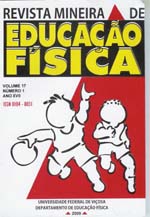EFFECT OF THE RELATIVE AGE IN THE PROFESSIONAL PLAYERS OF THE FIRST DIVISION OF THE STATE CHAMPIONSHIP OF RIO DE JANEIRO 2014
Keywords:
relative age, basic categoriesAbstract
In the face of the incessant quest for new talents, some processes of selection of young players were created throughout history with the aim of improving the system of recruitment and selection of young talents. One of the major trends used by clubs, coaches and “football professionals” in the selection process is the imposition of the Relative Age (difference between biological and chronological age). Objective: To analyze the distribution of dates of birth and identification of the birth quartile of the athletes who played in the clubs that participated in the first division of the Carioca Championship of 2014. Sample: The sample was composed by 771 athletes, representing 16 clubs in the state championship in 2014. Methods: Data collection was performed on the website of the Football Federation of the State of Rio de Janeiro (FERJ). Results: From 771 athletes collected, the first quartile had 312 players (40.5%), the second quartile had 220 players (28.5%), the third quartile had 148 players (19.2%) and the last and fourth quartile had 91 players (11.8%).). Conclusion: There was a strong trend in the selection of players born in initial quartiles (1st and 2nd) due to the advantages of biological maturation obtained in the base categories, however these advantages will be diminished and annulled in the adult phase, however it is possible to verify in the adult/professional category the effect of the relative age coming from the selection process of the basic categories
Downloads
References
BARNSLEY, R. H.; THOMPSON, A. H.; BARNSLEY, P. E. Hockey success and birthdate: The RAE. Canadian Association for Health, Physical Education, and Recreation, v. 51, p. 23–28, 1985.
BAXTER – JONES, A. Growth and development of young athletes: Should competition levels be age related? Sports Medicine, 20. 59-64. (1995).
BELLI, R.J..; SILVA C.D. ; RAMOS M.R. , Miranda, P.B.; Efeito da idade relativa no futebol: análise da Copa do Mundo FIFA e a influência continental. Revista Brasileira de Futebol , Jan-Jul. 2011.
CARLI, G.C., LUGUETTI C.N., RÉ, A.H.N., BÖHME, M.T.S. Efeito da idade relativa no futebol. Revista brasileira Ciência e Movimento 2009; 17(3):25-31
CARVALHO, Vladimir; MAURÍCIO, Ivan. As Melhores Frases do Futebol - Col. O Saber & O Sabor. Editora Garamond Ltda. 2003.
DELORME, N.; BOICHÉ, J.; RASPAUD, M. Relative age effect in elite sports: Methodological bias or real discrimination? European Journal of Sport Science, v. 10, n. 2, p 91-96, 2010. http://dx.doi.org/10.1080/17461390903271584
FERJ- Federação de Futebol do Estado do Rio de Janeiro; http://www.fferj.com.br/Campeonatos?alias ;acesso em 14 de setembro de 2014 as 16.00 hs .
FERREIRA, J. M. S.; Influência do Efeito da Idade Relativa no Desporto Escolar :Estudo centrado na distribuição das datas de nascimento dos participantes em fases nacionais das edições 2008-2011. Vila Real, 2011.
FOLGADO, H. A.; CAIXINHA, P. F.; SAMPAIO, J.; V.MAÇÃS. Efeito da idade cronológica na distribuição dos futebolistas por escalões de formação e pelas diferentes posições especificas. Revista Portuguesa Ciência e Desporto, v.6, n.3, p.349-355, Outubro, 2006.
FONSECA, H., F. T.; O efeito da Idade Relativa no Futebol. Estudos realizados em jovens jogadores Internacionais nos campeonatos do Mundo sub – 17. Porto H. Fonseca. Dissertação apresentada a faculdade de Desporto da Universidade do Porto. 2012
MARQUETA, P.M.; MEDINA, J.A.; LAMIGUEIRO, M.C.; PINEDO, C. S. A. O.; VIRÓN, P.C.; SALILLAS, L. G. Edad cronológica como factor de elección de jugadores de lãs selecciones españolas de baloncesto de formación. Archivos de Medicina del Deporte (2003).
MAZZUCO, M. A. e PEREIRA, J. L. Influência na idade na seleção de atletas para a categoria sub-15. A cidade do futebol, 2007. Disponível em http://www.cidadedofutebol.com.br/2007/08/1,1318,INFLUENCIA+DA+IDADE+NA+SELECAO+DE+ATLETAS+PARA+A+CATEGORIA+SUB-15. Acesso em 05/10/2014
MUSCH J, GRONDIN S. Unequal competition as an impediment to personal development: a review of the relative age effect in sport. Dev Rev 2001;21:147-167.
PENNA, E. M; MORAES, L. C. C. A.; Efeito relativo da idade em atletas brasileiros de futsal de alto nível - Escola de Educação Física, Fisioterapia e Terapia Ocupacional, Centro de Excelência Esportiva (CENESP) e Laboratório de Psicologia do Esporte (LAPES) da Universidade Federal de Minas Gerais, Belo Horizonte, MG, Brasil - Motriz, Rio Claro, v.16 n.3 p.658-663, jul./set. 2010.
PAOLI, P. B.; SILVA, C. D.; SOARES, A. J. G. Tendência atual da detecção, seleção e formação de talentos no futebol brasileiro. Rev. Bras. Fut., v.01, n.2, p.38-52, Jul/Dez, 2008.
TUBINO, M. J. G.; MOREIRA, S. B. – Metodologia Científica do Treinamento Desportivo - 13.ed. – Rio de Janeiro: Shape 2003.
WATTIE, N.,COBLEY, S. & BAKER, J. Towards a unified understanding of relative age effects. Journal of Sports Sciences. 26(13), 1403-1409. 2008.
WILLIAMS, J.H.; Relative age effect in youth soccer: analysis of the FIFA U17. Scandinavian Journal of Medicine & Science in Sports, Copenhagen, v.20, n.3, p.502- 08, Jun.2010.
Downloads
Published
How to Cite
Issue
Section
License
Os artigos submetidos e publicados são de inteira responsabilidade de seus autores, não refletindo necessariamente a opinião do Comitê Editorial. A revista se reserva o direito de efetuar, nos originais, alterações de ordem normativa, ortográfica e gramatical, com vistas a manter o padrão culto da língua, respeitando, porém, o estilo dos autores. O manuscrito submetido deve ser original, não podendo ter sido publicado em qualquer outro veículo de informação científica, e nem submetido para publicação em outra revista científica. Os trabalhos publicados passam a ser propriedade da revista Mineira de Educação Física, ficando sua reimpressão total ou parcial de acordo com a licença Creative Commons Attibution 4.0. Deve ser consignada a fonte de publicação original. Os originais não serão devolvidos aos autores. As opiniões emitidas pelos autores dos artigos são de sua exclusiva responsabilidade.





 Esta obra está licenciada com uma Licença
Esta obra está licenciada com uma Licença 